Are you sure you want that inside you?
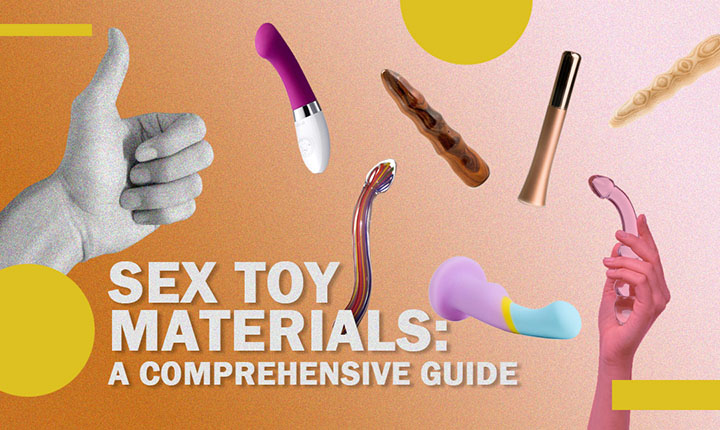
Jelly, glass, PVC, unpolished stone – these materials all become sex toys that purveyors encourage us to slide inside our bodies. But consumers can’t take sex toy creators and sellers at their word.
It’s up to buyers to protect their private regions and not be afraid to say: “No way am I sticking that up in me.”
Tons of toys are body safe and great to play with for anyone who wants to enhance their sex life.
However, we’ve seen the worst of what’s out there and want to keep you and your genitals far from toxic materials.
Think about it – you keep yourself safe from Sexually Transmitted Infections, (STIs), and unwanted pregnancy – shouldn’t you also look for the best materials on the market?
There’s no reason for anyone to run to the emergency room with a painful rash or swollen labia, all thanks to some self-love.
This comprehensive guide will help get you off in the right direction and check the toys you already own. We spent over 40 hours researching to uncover the truth about toy materials, and all the claims we make are backed up.
Guide is organised from safest to medium-safe, to dangerous toy materials you should avoid.
Then we suggest several tests you can make at home to ensure the toy you got is safe & explain how to make better choices when shopping.
Let’s jump in?
How Do Unsafe Sex Toys Make It To Market
Normally, materials used inside a human body have to get approval from the Federal Drug Administration, (FDA), and earn the label Medical Grade. But the FDA doesn’t put sex toys in the same category as syringes or surgical gloves.
While at first glance it looks like sex toy manufacturers don’t want their products considered medical as to avoid being sued, it’s really more straightforward than that. Most sex toys get manufactured in China.
If each sex toy company complies with the FDA’s regulations, obtains the “medical grade” label, and maintains a high standard, exporting those toys becomes much more expensive.
This convenient loophole combined with the race to make the most money in the sex toy market means plenty of toxic toys make it to the toy store shelves.
That means it’s up to the consumer to do the research and find which toys are worth their dollars.
Despite an outcry for better toys from consumers for decades, it wasn’t until 2019 that an international organization tried to form a committee to oversee sex toy production.
Even that came to nothing as the committee wrote no rules or guidelines as of the publication of this article.
In the meantime, sex toy makers can put any claims or buzzwords on their packaging, knowing no one will check to make sure a single word of that label is true.
The Best Body Safe Sex Toy Materials
That said, there are sex toy makers, distributors, and sellers who work hard to keep customers safe. They only offer toys made of the best and most body-safe materials.
Here’s a quick look at what you want in a toy:

Silicone
Body-safe: Yes | Porous: No |Texture: Soft | Taste/Smell: None or very light plastic smell
Silicone is a polymer made up of inert silicone, (sand), and oxygen. Plastics for containers or bags come from oil, but silicone is oil-free and maintains quality for years.
Silicone is non-porous (well, technically it is micro-porous), meaning bacteria can’t hide inside the skin of your sex toy and it sterilizes easily.
It makes for a good sex toy thanks to a lack of toxins and durability. It holds up against extreme temperatures, age, and use. Formed into a dildo or vibrator, it has a skin-like texture that feels smooth and natural inside of you and in your hand.
Silicone became the go-to material for toys when customers showed a clear preference for the high-grade material. But that wasn’t the case for a long time.
Plenty of toy companies try to pass off cheaper, similar-looking materials for silicone, but don’t let them fool you.
Even if you see that magical “medical grade” phrase, read reviews from previous customers and make sure no one mentions an unpleasant smell coming out of a freshly opened box, and transparency in the toy, or oily texture to the toy’s surface.
Though, know that some smell can be there even from silicone initially, but it’s from packaging and will fade off fast.
Further down in the article we’ll share several simple tests you can do at home to ensure the toy you received is actually silicone & safe to use.

Borosilicate Glass
Body-safe: Yes | Porous: No | Texture: Hard | Taste/Smell: None
Glass sex toys look beautiful, feel smooth against the skin, and even smoother when slid up and into a vagina. But that weighted glass can contain heavy metals, and we want those far from our private areas.
When you buy glass, look for the label borosilicate. Borosilicate is the reason your great-grandmother’s baking dish still holds up in the oven.
The material is so strong it can hold boiling water or go in the freezer with no damage to the object for years.
Many people confuse Pyrex as synonymous with borosilicate, but I have bad news. Back in the 1990s, the company Pyrex got bought out by a Chinese company called World Kitchen.
World Kitchen carried on putting the word pyrex on all their products but didn’t use the same high-quality process to make it.
Instead, they replaced the borosilicate glass with a cheaper soda-lime glass that doesn’t stand up to stress like its more expensive predecessor.
That means your glass dildo would be more susceptible to mini cracks on the surface, making it porous (and potentially dangerous) to use.
Later in the article, we’ll look at how to test your glass toy to ensure it’s borosilicate glass, not soda-lime.
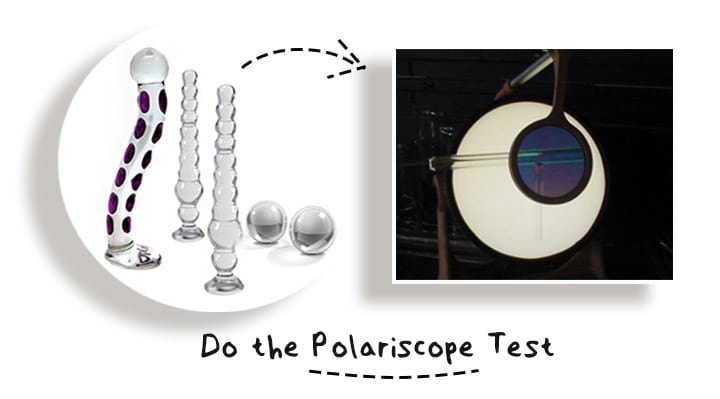
Metal & Stainless Steel
Body-safe: Yes | Porous: No | Texture: Hard | Taste/Smell: None
Sex toys come in a number of metals. One of the best is stainless steel. The strong, smooth material doesn’t crack, chip, or rust and looks amazing when formed into a butt plug or dildo.
Stainless steel is an alloy made from iron ore, chromium, silicon, nickel, carbon, nitrogen, and manganese. Nitrogen and carbon are added in the production process to help it stand up to corrosion.
Look for 316L and 316LVM in any stainless steel sex toys. These are the same grades used in surgery, and they’re safe.
Another safe to use metal is aluminum. Look for anodized aluminum (it is resistant to corrosion).
A cheaper, lighter option for toys is zinc alloy. These toys get labeled “metal” without any other description on websites or in stores.
From a distance, it looks similar to stainless steel, but up close it lacks the luster of the more expensive metal.
These metal toys are zinc combined with another metal (usually copper) and also used for jewelry. It’s a cheaper choice, so expect a green patina on the surface after a lot of use.
It’s body-safe, but it won’t hold up the same way stainless steel can over the years.
Wood
Body-safe: Yes | Porous: No | Texture: Hard | Taste/Smell: None
Made from hardwoods like oak, maple, or hickory, wooden toys can be a lovely addition to your sex toy collection.
They’re worked and polished to a high sheen to achieve a smooth, gliding surface. Professional wooden toys get a layer of body-safe lacquer.
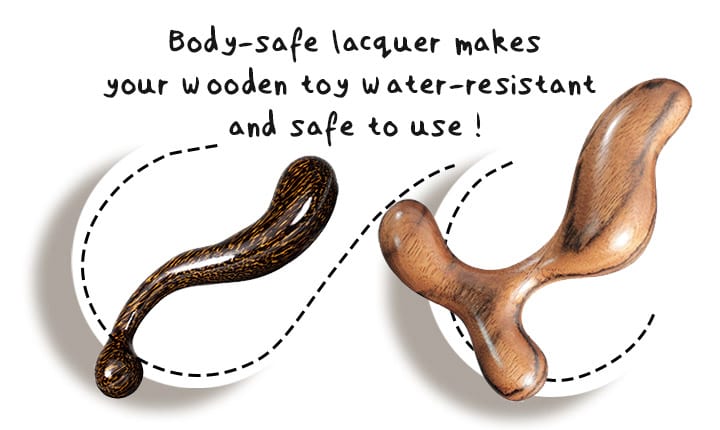
Other craftsmen use a food-safe wax or oil that creates a “salad bowl finish.” That’s okay for temporary use, but without a high-quality, body-safe lacquer, your toy could absorb moisture and warp.
Be careful not to buy any wood products with the word “stained” in the description. A lot of mass-market stain companies allow Volatile Organic Compounds, (VOC), in their products.
That’s dangerous stuff inside your body!
ABS Plastic
Body-safe: Yes | Porous: Possibly | Texture: Hard | Taste/Smell: None or very light plastic smell
Acrylonitrile Butadiene Styrene (ABS) is an amorphous copolymer. It’s plastic made from a combination of materials and commonly used for helmets, medical equipment, and cameras.
This specialized plastic turns into a liquid at a high temperature. It can then cool into a new shape.
This means manufacturers can recycle ABS from one thing into another and even inject it into molds to make for smoother, more expensive-looking toys.
There seems to be no definite standpoint about the ABS and its porosity – some say the ABS toys are non-porous, some claim they are porous but safe.
Well, ABS is being used widely for medical equipment. Also, I have not yet come across the cases of any Urinary Tract Infections (UTIs) brought by the prolonged (but proper) use of ABS toys, which is an issue with the cheaper and porous materials like PVC or jelly.
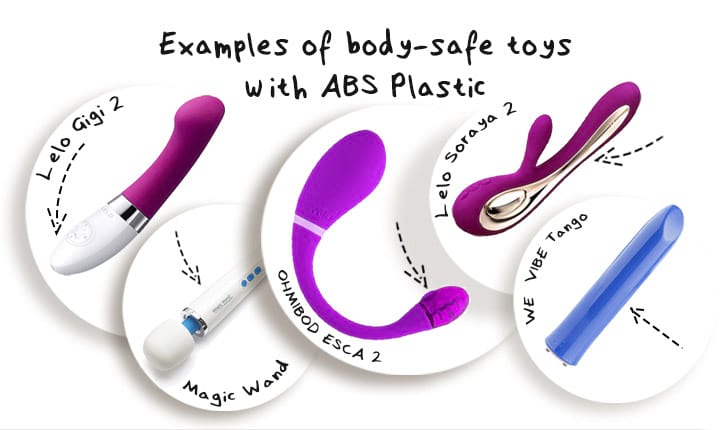
If you are not sure about the quality of your plastic toy use it with a condom.
While ABS plastic won’t break down or fracture from use, it’s always good to err on the side of caution. Clean it with a cleanser or a little soap and water after each use.
Porous Materials You Should Be Careful With
While the best toy materials are what you should shoot for, you might feel tempted to try out a skin-like masturbator or dreamy crystal toy. If you do, we want to help you find the best toys so you can stay safe and keep it sexy.
Stone / Crystal Sex Toys
Body-safe: Yes | Porous: Sometimes | Texture: Hard | Taste/Smell: None
Stone toys may make you imagine ancient tribes making dirty jokes. It’s true, we’ve been horny since we became human, and stone remains a popular choice for sex toys.
You’ll see a lot of beautiful crystals, like jade, made into yoni eggs. However, a lot of these materials can scratch and then scrape your insides with the new, rough line on their surface.
They’re also often made of porous materials, (jade included), and can cause infection. If you want to strengthen your pelvic floor, you can do Kegels for free – no expensive egg necessary.
If you’re madly in love with stone sex toys, you have some options. Look for quartz, rose quartz, and amethyst in your stone toys.
These are single-crystal materials and don’t have a porous surface.
All other crystals are highly porous and give bacteria plenty of hiding places. If you want a stone dildo, use it with a condom.
Keep it clean and stored in a secure place to ensure you don’t get any kind of infection.
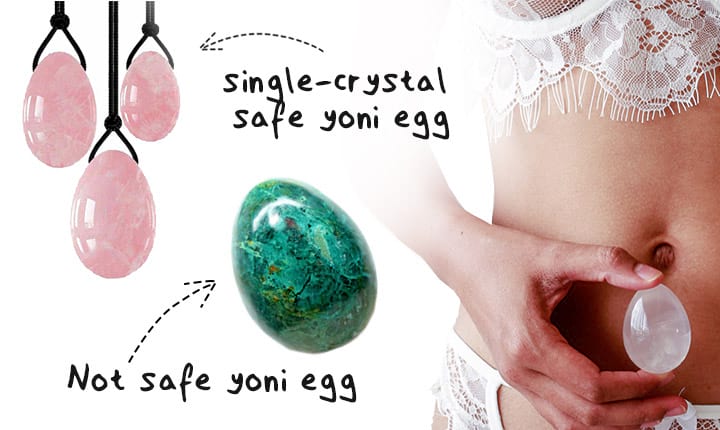
TPR / TPE: ThermoPlastic Rubber & Elastomers
Body-safe: Yes | Porous: Yes | Texture: Flexible and strong | Taste/Smell: Rubbery
ThermoPlastics and elastomers, (TPRs or TPEs) are what manufacturers reach for to make softer, more malleable pleasure sleeves or masturbators.
It has a softer feel to it and bends and moves with thrusts and pulls without breaking.
TPRs and TPEs come from copolymers or rubbery plastics that go through an extensive chemical process to keep them soft. They hold up a decent time and don’t break down during use.
That said, it is still highly porous. To make sure your toy is safe to use, you have to clean it with water and mild soap and scrub it really well with your finger to make sure the textured, internal center stays safe.
You cannot fully sanitize toys made of such material. Don’t swap or share your toy with anyone. This soft rubber can hold onto flora from one body to the other.
And make sure that your TPE toys are fully dry before storage to prevent mold from appearing.

Latex
Body-safe: Yes | Porous: Yes |Texture: Flexible and thin | Taste/Smell: Rubbery |
Latex is a thin, rubbery material used to make fetish clothing and any toys that inflate. It is porous and impossible to sanitize, so use any latex toys with a condom.
A quick note about latex condoms
Latex condoms manufactured for penises are held up to a rigorous set of standards and do not get manufactured the same way as other latex products.
They have to be closely monitored and regularly tested, unlike the other items in this guide.
Natural Latex Rubber is produced from a milky substance from the rubber trees. It is then processed and rolled out into sheets of vegan latex.
There is a synthetic latex too, that is treated with chemicals. It is not usually used in the production of clothes as it doesn’t have the flexibility the natural rubber has.
However, you can check if you have a true latex product. Give your latex a hard pull to see how much it stretches. Real latex can stretch quite far without tearing.
Another check is if the latex has two sides – a shiny side and a matte side. The matte side should feel soft and velvety to the touch.

A lot of customers mistake PVC for latex, but PVC is processed with tons of phthalates.
Thus, always go for vegan, properly processed latex to avoid any dangerous chemicals.
Unfortunately, a PVC product can legally put “latex” on the product’s label. Most sellers put “PVC” on the label for any plastic-coated fabric.
It lacks the supple feel and thickness of the real latex and often has a cheap look.
The confusion with labeling is another strong reason to purchase from reliable sources!
Before you buy latex anything, ask your partner if they are allergic to latex. About one percent of humans have a latex allergy and can experience a nasty rash, swollen skin, or a life-threatening reaction if they’re not careful.
If you think you could be allergic to latex, ask your doctor to conduct a blood test.
Dangerous And Toxic Sex Toy & Dildo Materials
Let’s pivot to the nasty stuff that still floats around the world of sex toys. These materials can do actual damage to your body either immediately or over time, and you need to be vigilant about avoiding them.
Polyvinyl chloride (PVC)
Body-safe: No | Porous: Yes |Texture: Flexible and soft | Taste/Smell: Rubbery
PVC is a plasticizer that many sex toy makers use to keep their toys soft and give them more bend. This is an issue because the chemicals inside it then leach out from the toy to the user.
One of those additives is called phthalates. These chemicals get added to plastics, pesticides, detergents, and other compounds.
However, some recent consumer outcry has helped call attention to their potential danger.
Health issues like malformed fetuses in the womb are among the many problems linked to phthalates.
The CDC claims phthalates won’t hurt us and wants to study them for longer periods of time, but seems to be dragging their feet on the issue.
However, the level of phthalates in sex toys leaves many questions unanswered. Sex toys with PVC can leach oil and smell terrible after a short time.
It makes shoppers wonder, how much of this junk is in our toys and how could anything that smells this bad possibly be body-safe?

Jelly
Body-safe: No | Porous: Yes | Texture: Flexible and soft | Taste/Smell: Oily and rubbery
Many sex toy shoppers encounter jelly toys in their shopping. These toys normally have a semi-clear appearance and come in a range of colors. They’re made from plastic that’s softened with extra phthalates to give them that jellyfish texture.
Jelly toys aren’t as common as they were in the early days of sex toys, but they’re still out there. The chemicals that soften them are already being phased out in toys for children because little ones shove things in their mouths.
If these chemicals are too dangerous for a child’s mouth, there’s no way they should go inside a vagina or anus.
Jelly toys are also highly porous and nearly impossible to sterilize. When you see them, it means you’re dealing with a low-quality seller, and you need to move on.
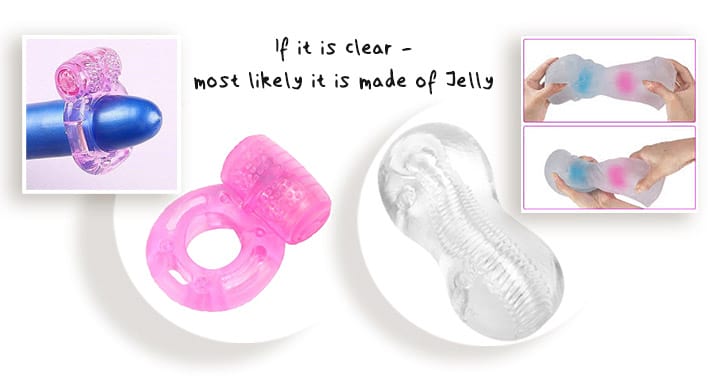
Cyberskin and Fanta Flesh
Body-safe: No | Porous: Yes | Texture: Flexible and soft | Taste/Smell: Oily and rubbery |
The names CyberSkin or Fanta Flesh appear on toys trying to mimic human skin for your pleasure. Straight out of the package, the skins of the toys feel silky and soft.
Creators like them because they’re cheap and help them produce toys like masturbators or dildos that look and feel real.
But that soft, skin-like texture comes from a mix of PVC and extra phthalates.
Also, the toys don’t stand up to repeated use, so they start to break down and leach oils after a few rounds.
They cost less, sure, but those extra chemicals put users at risk and aren’t worth the few bucks you’ll save.
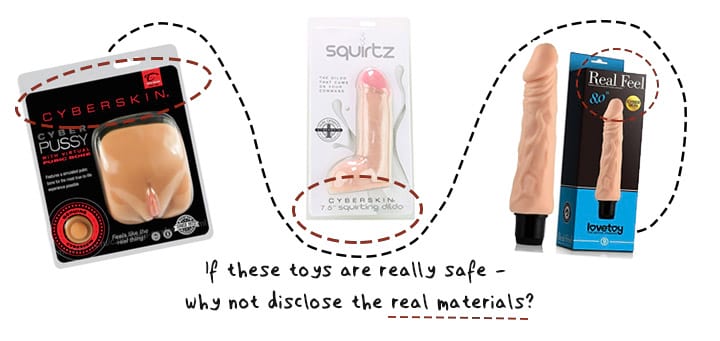
If you want a safe masturbator or dildo that won’t break down or hold onto bacteria, look for the ones made of pure silicone.
How To Test If The Toy Material is ACTUALLY Safe At Home
It’s worth trying out a few quick tests at home to see if any claims on your toy’s packaging are false. Here’s a set of experiments anyone can do to test a toy.
Flame Test
To test plastic toys you can use a bunsen burner and tongs to see if your toy’s material is flammable.
If your toy does not burn at all, it’s a good-quality silicone. Any plastic made with oily phthalates will light up. A jelly toy will go up the fastest.
NOTE
Please make sure you and your surroundings are secure before you light anything on fire.
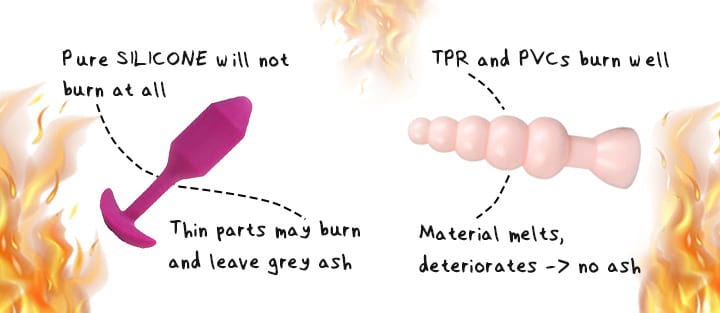
Smell Test
This quick test helps you check toys that claim to be silicone. When you open a new toy, put your nose down into the packaging and give it a sniff.
It should have a clean, neutral smell. If you smell something strong or unpleasant, you have a chemical-laden toy.
The packaging of your toy might alter the scent. If you suspect your toy’s box or bag could be the cause of the smell, separate the toy out and give it another sniff.
You want your product to smell neutral; no off-putting chemical scent should be present.
Lick Test
Another easy method is to give the toy a lick with the tip of your tongue, then wait a few moments to see if your tongue gets a numb sensation.
A safe toy won’t affect you, but a dangerous one will.
Polariscope Test
You’ll need to order your own polariscope online for this test. You can get a small one for about $26, a bigger one for around $80.
A polariscope looks similar to two small connected camera lenses. It’s made of two polaroid plates that, held up to the eye, help you analyze light.
This is a great tool for checking your glass toy.
You can place a quality glass dildo or butt plug between the two plates on top of a small light source, (like a little lightbox that comes with the scope).
The light coming through the glass should appear grey when seen through the scope.
That means the glass toy annealed properly and won’t break under pressure. But, if you see a rainbow, the annealing process didn’t happen properly and your toy could chip or crack on the surface.
You can even make your own polariscope using any LED light source and some cheap 3D glasses.
Order a Lead Test
To test your plastic or metal toys, you can order an instant lead test for about ten bucks. The kit is two simple swabs.
Swipe them over any metal or plastic toy and see if the tip turns red. If so, your toy contains lead. No red? You’re good to go.
Where To Buy Safe Sex Toys & What To Avoid
A safe sex toy starts with a reputable seller. You want to buy toys from manufacturers that won’t lie for profit.
To keep yourself out of the danger zone, stay away from some bigger, everything-for-sale shops like Amazon, eBay, or Aliexpress.
Sure, these stores may carry some excellent products, but they don’t check product claims or sellers of each toy.
That leaves the door open for counterfeit sellers to walk in and make some money fast.

Stick With Reliable Sellers
There are some good guys out there working hard to keep you happy. The following shops sell what they promise and check the quality of their products before selling them to you.
First and foremost is Lovehoney. They offer material guides of their own, disclose the details of their products, and include instructional videos for new buyers.
Then you have the superheroes of SheVibe, a store that celebrates the opportunity to educate their buyers and comic book culture.
Tantus states on their site how they produce silicone products and even point out to shoppers the lack of regulation in sex toys and how Tantus regulates themselves.
Happily, a lot of other companies are also upping their quality and keeping an open dialogue with customers to improve safety.
You have tons of shopping options, so don’t feel limited when you need a new toy.
Conclusion
It’s a shame that consumers have to hold an entire industry accountable, but that’s the reality of our situation. So, be vigilant and keep informed about all new sex toys before you buy them.
Review your purchases, be open and honest about your experiences on forums to keep the conversation alive.